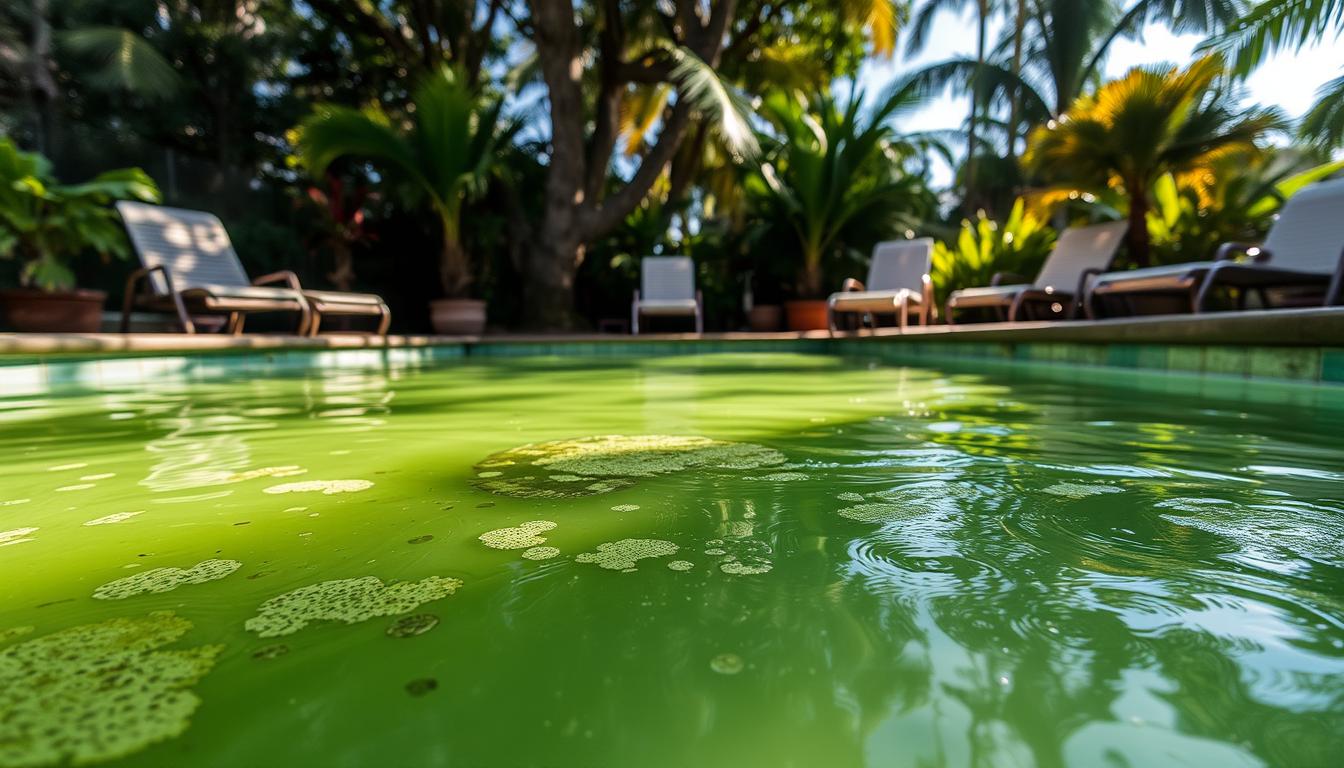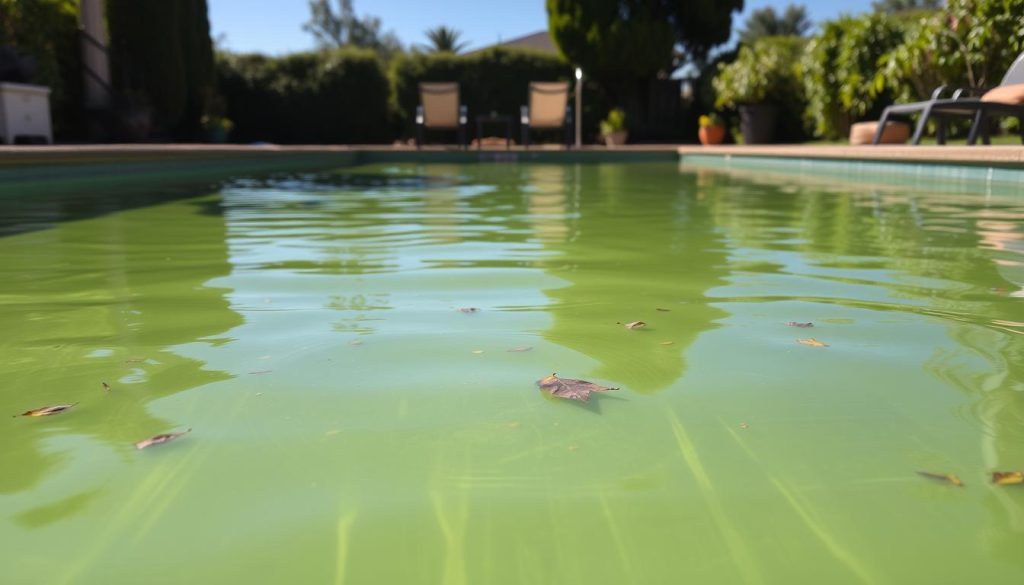
Imagine approaching your pool on a sunny day. You’re excited for a swim, but the water is green. This scenario is common for many pool owners, despite recent shocking efforts.
Coastal Luxury Outdoors has extensive experience in pool care. We’ve served over 1,000 clients annually and built more than 100 pools each year. Our experts have encountered various pool maintenance challenges.
Several factors can keep your pool green after shocking. These include weak shock treatment, poor water circulation, and high phosphate levels. Low free chlorine levels can also contribute to persistent algae growth.
Phosphate levels exceeding 500 parts per billion provide ample food for algae. This makes it difficult to eliminate the green color. High pH levels above 7.4 can also reduce the effectiveness of shock treatments.
We’ll explore common causes of green pools and provide solutions. You’ll learn how to troubleshoot and prevent future issues. With our guidance, you’ll soon enjoy a crystal-clear pool again.
Why Pools Turn Green
Pool owners often face the problem of green water. Several factors can cause this issue. Understanding these causes helps treat and prevent green pool water effectively.
Algae Overgrowth
Algae growth is the main reason pools turn green. These tiny plants thrive in water and grow quickly. Poor chemical balance, weather changes, and bad circulation can cause algae growth.
High phosphate levels in pool water can also help algae spread. This can lead to algae taking over the pool.
| Factor | Ideal Range/Value | Impact on Algae Growth |
|---|---|---|
| pH | 7.3 to 7.6 | High pH can prevent chlorine from effectively killing algae |
| Filter Runtime | At least 8 hours a day | Inadequate filtration can lead to algae accumulation |
| Phosphate Levels | Below 100 ppb | High levels can contribute to algae growth |
Metals and Pollen
Metal parts in the pool can react with chemicals and turn green. Ladders and pumps are common culprits. Pollen from plants can also give water a greenish-yellow tint.
Low Free Chlorine Levels
Chlorine is the main pool sanitizer. Low free chlorine levels can’t kill algae effectively. Aim to keep free chlorine between 1 and 3 ppm for clean water.
Shocking the pool with a large amount of chlorine can kill algae. Use 1 pound per 10,000 gallons of water. Adjust based on algae levels and repeat if needed.
High pH
High pH levels can make chlorine less effective. The ideal pH range is 7.3 to 7.6. When pH is too high, chlorine can’t fight algae growth well.
To keep your pool clean, balance chemicals properly. Regular testing and adjusting are crucial. Ensure good filtration and manage environmental factors to prevent green water.
Is Your Pool Still Green After Shock and Algaecide?
Has your pool stayed green after shocking and using algaecide? Don’t fret. We’ll help you find the causes and fix your pool’s clarity issues.

Weak Shock Treatment
Expired shock or low dosage can keep pools green. Use 1 pound of shock per 10,000 gallons of water. Severe cases may need more.
Shock your pool at night. This prevents the sun from breaking down chlorine too fast.
Poor Water Circulation
Bad circulation can make shock treatments less effective. Run your filter for at least 8 hours daily. Heavy pool use may require longer run times.
Clean your filter often for the best water flow:
- DE filters: Clean every 1 to 3 months
- Sand filters: Clean every 1 to 4 weeks
- Cartridge filters: Clean every 2 to 6 weeks
It’s Not an Algae Problem
Green water doesn’t always mean algae. High copper levels, common in well water, can turn pools green. Pollen and debris in pool dead spots can also cause green tints.
Not Brushing or Vacuuming Thoroughly
Brush pool walls and floors well to remove pollutants and dead algae. Pay extra attention to corners and hard-to-reach spots.
Vacuum the pool to clear debris and dead algae from the bottom.
| Problem | Solution |
|---|---|
| Expired shock or insufficient dosage | Use fresh shock and increase dosage (1 pound per 10,000 gallons) |
| Poor water circulation | Run filter for at least 8 hours daily and clean regularly |
| High copper content or pollen | Contact pool care specialists for proper treatment |
| Inadequate brushing and vacuuming | Brush pool walls and floor vigorously and vacuum thoroughly |
If your pool stays green after trying these fixes, call pool service experts. They can find the best solution for your pool problems.
pool is still green after shocking
Is your pool still green after shocking? Don’t worry, we can help. Several factors affect pool shock treatment. Addressing these issues can restore your pool’s crystal-clear appearance.
Adjusting Pool pH for Effective Shock Treatment
Pool pH is crucial for effective shock treatment. The ideal pH range is 7.2 to 7.4. Use sodium bisulfate to lower high pH levels.
For low pH, use baking soda to raise it. Proper pH ensures chlorine effectively combats algae and contaminants.
Checking CYA Levels and Their Impact on Chlorine Effectiveness
CYA (cyanuric acid) protects chlorine from UV degradation. Both low and high CYA levels affect chlorine’s effectiveness. Too little CYA leads to rapid chlorine dissipation.
Excessive CYA can lower pH and reduce chlorine’s sanitizing power. Regular testing and adjusting of CYA levels is essential.
| CYA Level (ppm) | Impact on Chlorine Effectiveness |
|---|---|
| 0-30 | Insufficient protection, rapid chlorine dissipation |
| 30-50 | Ideal range for chlorine stability and effectiveness |
| 50-100 | Reduced chlorine effectiveness, potential pH imbalance |
| 100+ | Significantly diminished chlorine effectiveness, pH issues |
Brushing and Vacuuming to Remove Dead Algae
Brushing and vacuuming are key to removing dead algae after shocking. Brush pool walls and floor to dislodge algae. This makes it easier for the filtration system to remove debris.
Manual cleaning with polypropylene bristles can remove algae and improve clarity. Vacuum thoroughly to remove dead algae and prevent future growth.
Statistics show that regular brushing and cleaning of pool surfaces can help in mechanically removing algae and debris, contributing to a cleaner and healthier swimming environment.
If the pool remains green, check for copper oxidation. Use a copper-free algaecide and a flocculant to gather algae for easy removal.
Maintain proper pool chemistry to keep your pool sparkling. Follow these steps for a refreshing swim all season long.
How to Prevent Green Pool Water
Explore alternative pool sanitation systems like saltwater or UV light pools. These can reduce chlorine needs but may require infrastructure changes. Regular maintenance and proper chemical balance are key to preventing green pool water.
Test pool water often and adjust pH, chlorine, and CYA levels. Keep pH between 7.0 and 7.2, and chlorine at 1.5 to 2 mg per liter. Run your pool filter for at least 8 hours daily.
Clean the filter regularly to prevent water stagnation and algae growth. Brush and vacuum your pool weekly to remove debris and deter algae.
Maintain a healthy pool with regular upkeep, proper chemical balance, and a good filtration system. With some effort, you’ll have a sparkling oasis all summer long.







